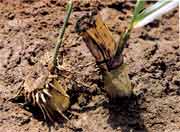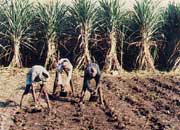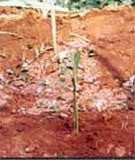|
Chewing Cane
- Sugarcane has been used for chewing since time immemorial.
Infact, chewing, perhaps, was the first use of cane.
Now chewing canes are in great demand during festival
times, both for worship and chewing. During ‘Pongal’,
the harvest festival of Tamil Nadu, chewing canes are
sold at a very high cost.
- For chewing, canes having more sugar, soft with less
fibre, less rind thickness and less rind hardness are
desirable. They are specifically growth for harvest
during this festival season. They must be attractive
in colour, thick, easy to peel and split, should be
juicy having more sugar, and should have less or no
wax on the rind surface. The ‘Pongal cane’
is thick, has short internodes, high juice content with
low fibre. It is poor in tillering and is shallow rooted.
It is found susceptible to drought and pests and diseases.
- They may be planted during appropriate season so that
they are available for selling when there is great demand.
The Pongal cane may be planted during January-February
so that it could be harvested during the Pongal season.
- They should be given high amount of organic manures
and also inorganic fertilizers and should be growth
with adequate irrigation. A robust cane will fetch a
better price.
- There should not be any infestation of pests, particularly
that affecting stalks. Also disease such as red rot
or wilt should not affect the cane. If ever such clumps
are observed, they must be removed.
- Cane should not suffer from drought which is likely
to shorten the internodes.
- Good quality irrigation helps in improving chewiness.
- Soil should be fertile, well drained without any problems
such as salinity, alkalinity etc.
 Top
Top
Cane Cultivation for Jaggery Production
- In jaggery production, important considerations are the
yield, quality and shelf life or keeping quality.Jaggery yield
mainly depends upon the cane yield, juice volume and total
sugar content.
- Quality of jaggery depends upon the juice quality which is
determined by the variety, growing conditions, quantity and
quality of inputs used and the jaggery preparation technique.
- Jaggery quality is determined in terms of colour, hardness,
structure, taste, flavour and shelf–life.
- Jaggery out-turn depends upon high total sugars. High sucrose
and high purity are essential for high quality jaggery. Higher
total N in juice produces soft jaggery. Higher amino acid
content gives dark coloured jaggery.
Varieties
- Variety plays an important role in the quality as well
as recovery of jaggery from cane. Juice quality is primarily
a varietal character. Therefore, varieties having high sucrose
content, high purity, low colloids and other desirable juice
characteristics should be chosen for jaggery production.
- In general early maturing high sugared varieties yield better
quality jaggery. Usually a variety which is good for sugar
production is equally good for jaggery also. However, varieties
like CoC 671, Co62175, CoSi 86071 are specially well suited
for jaggery.
Agronomic practices
Soil
- A well-drained medium to light textured loamy soil with
adequate amounts of available nutrients and of neutral pH
is desirable for growing sugarcane for jaggery production.
- Well drained soils with low clay content will have less salts
and thus are good for jaggery cane. Sugarcane grown in calcareous
soils produces poor quality jaggery. In salt affected soils,
jaggery recovery gets reduced.
- In coastal areas, lodging of cane occurs which affects juice
quality and thus leads to poor quality jaggery. Sugarcane
grown in deep black soils have been reported to produce black
colour jaggery.
- Jaggery from sugarcane grown in swampy soils is of poor keeping
quality. Thus it is better to choose a well drained light
textured soil without any salt problem for growing sugarcane
meant for jaggery preparartion.
Planting
- Early planting ensures high yield as well as better quality
juice. However, time of planting should take into consideration
the time of harvest. Many a time there will be great demand
for jaggery during festivals like Diwali.
- Time of planting will have to be so adjusted that mature cane
is available for jaggery preparation during such periods.
Mannures and Fertilisers
- Manuring practice should be optimum so that yield and
quality of cane is ensured. Particular emphasis should be
given to avoid over and late manuring.
- Over manuring, particularly of nitrogen, leads to poor juice
quality which in turn will affect jaggery quality. High soluble
nitrogen in juice will produce soft jaggery of poor keeping
quality. Late applications also lead to similar problems.
- Organic sources are known to give better quality jaggery.
However it is not possible to rely only on organic sources
for supplying all the nutrients in required quantity. A judicious
mix of organic and inorganic sources is useful.
Irrigation
- Irrigation requirement of sugarcane grown for jaggery
is same as that for sugar production. Quality of irrigation
water is highly important. Saline water with high content
of soluble salts leads to accumulation of these salts in the
juice which in turn will give saltish taste to the jaggery.
Pests
- Pests and diseases that affect cane stalk will also affect
juice quality and thus jaggery yield and quality.
Harvesting
- Cane should be harvested at peak maturity. Immature cane
gives poor quality jaggery having less sugar, more of non-sugars
and reducing sugars and of poor shelf life.
- Over aged cane will also affect jaggery quality. As overaging
leads to cane drying,there will be less juice extraction and
thus jaggery yield will be affected. Reversion of sucrose
is a serious problem in over-aged canes.
- Harvested cane should be crushed within 24 hours. Otherwise
cane staling takes place. The loss in sucrose has been estimated
at 0.1 to 0.2% for every 24 hours of delay in crushing. Harvesting
to the ground level is important because the lower internodes
are rich in sucrose.
 Top
Top
Ratoon Management
 |
- Ratooning is raising a fresh crop of sugarcane
from the preceding plant crop stubble regrowth
without fresh planting of setts. This is the
‘first ratoon’.
- When a ratoon is raised from the stubble regrowth
of the first ratoon, it is ‘second ratoon’
and so on.
|
- In India, raising one to two ratoons is most common, though
there are instances of many ratoons or "multiratoons"
in certain pockets of Tamil Nadu.
- Cane yield decline in successive ratoons is a common phenomenon
in most of the sugarcane growing countries of the world. A
10 percent decline is considered quite normal.
- Average yield gap between plant and the ratoon crop in the
country is 20-25 percent. Low ratoon yield is one of the reasons
for the low average yield of the country.
- The major causes for yield decline in ratoons in our country
are:
- Poor ratoon crop management.
- Reduced initial population because of reduced stubble sprouting.
- Decline in the soil nutrient status.
- Soil compaction and poor soil physical status.
- More incidences of pests and diseases.
Advantages of ratoons
- Ratoons are economical by about 25-30 percent in the operational
cost because of saving in the cost of setts and initial preparatory
cultivation.
- Ratoons save time as they establish early and in general mature
early. Therefore, they can be harvested early.
- Ratoons stabilise the cane area of a factory.
- Ratoons often give better quality cane.
Cultivation aspects for Ratoon Crop Variety
- Sugarcane varieties differ in their ratooning ability.
Most of the present day sugarcane varieties have good ratooning
ability.
- Generally early maturing varieties are poor ratooners than
mid-late or late varieties. Varieties giving high yields as
plant crops give better ratoon yield in most cases.
Plant crop and its harvest
- Good ratoons result from healthy plant crops. The plant
crop should be raised under optimum input levels, particularly,
nutrients and irrigation. Poorly grown plant crops due to
reasons like moisture stress, lack of sufficient nutrients
or due to certain pests, cannot give satisfactory ratoons.
- Plant population in the ratoons can be maintained if there
were adequate stubbles in the field. Thus for any reason,
if the plant crop has too low a cane population at harvest,
it is desirable to avoid ratooning. Pest and disease infected
plant crops also should not be ratooned.
Time of harvest
- Harvesting the plant crop when weather conditions are
conducive for stubble sprouting is important. Low as well
as high temperatures are harmful.
- When cane harvesting is done in the hot summer months, sprouting
is affected due to drying up of the buds and stubbles. Sprouted
buds also die. Thus plant population becomes heavy.
- Harvesting of cane at any time except very hot summer months
(April-June) would result in satisfactory ratoons. However,
December to February harvested crops always give best ratoons.
Duration of harvest
- For ensuring uniformity of the sprouts and further to
promote uniform growth of the ratoon crop, it is essential
that the duration of harvesting of a field is not extended
beyond a week.
Method of harvest
- Harvesting the plant crop close to the ground level is
very important not only to add a few more tonnes to the yield,
but also to get a better ratoon crop.
- Particularly important in places where stubble shaving operation
cannot be carried out due to either labour scarcity or unfavorable
soil conditions like either excess moisture or lack of it.
Trash disposal
- Trash disposal is an important task soon after the harvest
of the plant crop before any other ratooning operations could
be taken up.
- Green tops are mostly removed for feeding cattle and some
are used for tying the cane bundles.
- Still as much as 8-10 t of trash per hectare is left in the
field which must be disposed off.
- Most of the farmers burn the trash. Scientifically, trash
must be conserved and returned to the soil since it contributes
towards organic matter and nutrient status of the soil.
- Average nutrient content in the sugarcane trash has been estimated
to be around 0.35% N, 0.13% P2O5 and 0.65% K2O. When incorporated
in soil, trash helps in improving the soil physical conditions.
Conserving trash
- Trash can be removed to the bunds and then applied to
the fields after the initial ratooning operations are completed.
- Trash mulching is particularly useful in extremes of weather
conditions. Mulching also suppresses weed growth besides conserving
moisture.
- Mulched trash can be incorporated late into the soil while
earthling up after manuring. Composting of trash is another
way of conserving it.
Conserving trash
 |
- After harvest of the standing
crop and cleaning the field, an important operation
that has to be carried out is "stubble shaving".
- The stubbles protruding out of the field are cut below
ground level using a sharp spade. This is done to
facilitate healthy underground buds to sprout and
establish a deeper root system in the ratoon crop.
|
- For stubble shaving, a sharp implement, preferably a spade
should be used so that stubbles are cut with minimum damage
to the buds and to ensure that stubbles are not uprooted.
- If the soil has become hard and dry and it is difficult to
carry out these operations, the field should be irrigated
lightly and stubble shaving may be done when field conditions
are ideal for working with implements.
Off barring ‘or’ shoulder breaking’ and loosening the inter-spaces
- Soil compaction is one of the major causes for the poor
growth of ratoon cane. Because of this problem, movement of
air and moisture within soils is affected. This in turn affects
development of root system and finally the absorption of nutrients
and water.
- "Off-barring" is an operation wherein the ridges
are broken or cut on either side. This operation is also called
as "shoulder breaking". To loosen the soil, the
inter spaces between the rows are dug.
Gap filling
 |
-
One serious problem in ratoons is the occurrence of
gaps, which whein excess of 20 percent cause considerable
yield losses. Gaps occur because of poor sprouting.
- For gap filling, it is better to use pre-germinated
single bud setts. For this purpose, a month prior
to harvest of the plant crop, nursery may be planted
with single bud setts and seedlings of required
age can be obtained and planted in the gap.
|
- Material for gap filling can also be obtained from spots where excess sprouting is seen. Clumps can be uprooted and cut into quarters and planted in the gaps.
Polybag seedlings for gap filling.
- Another recent technique is to raise polybag seedlings
and use them for gap filling.
- For this purpose, single bud setts are planted in plolythene
bags (measuring 12 x 8 cm having a few punch holes for aeration)
filled with soil, sand and FYM in the ratio 1:1:1.
- Month old seedlings should be clipped off. Then after removing
the polythene bag, the seedlings along with the soil mass
should be placed in small pit made in the gap.
- A small quantity of super phosphate placed in the pit helps
better growth of the seedlings. In this method, 100% of the
seedlings gap filled will survive.
Fertilizer application
- Early growth in ratoons is relatively quicker. Hence there
is a need to apply fetilizers early.
- Entire dose of phosphorus, one-third each of nitrogen and
potassium may be applied soon after stubble shaving and off-barring
on either side of the ridge and covered with soil.
- This has to be followed by top dressing of remaining nitrogen
and pottasium around 30 and 60 days after, in equal splits.
Water management
- Ratoons are more susceptible to moisture stress due to
their shallow root system. Therefore irrigation is required
at frequent intervals, particularly in the early stage. Avoiding
excess irrigation and improving drainage are essential steps
to improve the ratoon productivity.
Management of Pests and Diseases
- Ratoons, due to their reduced vigour, are more prone to
pests and diseases than the plant crops. Several of the insect
pests are carried over to the ratoons through crop residues.
Therefore a pest-free plant crop ensures a better ratoon.
- Whenever the plant crop is affected by insect pests like scales,
mealy bugs, termites etc., trash must be burnt. Even ratooning
may be avoided if the infestation is high.
- There are three major diseases directly associated with ratoons:
ratoon stunting disease (RSD), grassy shoot disease (GSD)
and smut. With the increase in the number of ratoons these
diseases also increase.
- Healthy 3-tier seed nursery programme involving heat therapy
is a must in the disease management programme. In smut prone
areas strict roguing should be done. Smut whip should be removed
undisturbed and burnt.
Ratoon chlorosis
- In calcareous soils iron chlorosis is a problem. This
is more pronounced in ratoons, more so because of poor nutrient
status in the soils coupled with inability of the ratoons
to absorb nutrients, particularly in the early stage.
- For chlorosis management, ferrous sulphate spray at 2.5 g
/ litre along with urea at 10 g / litre may be done at weekly
intervals for young crops.
- The concentration of ferrous sulphate may be enhanced to 5
g / litre for crops above 60 days age. 2-3 sprays may be required.
Studies at Coimbatore have shown better chlorosis control
with the addition of ZnSO4 (5 g / litre).
Harvesting
- Generally ratoons mature about a month earlier. Therefore,
they are useful for early crushing. Towards the end of the
crushing season, plant crop harvests should be given preference
over ratoons, as otherwise ratoons of late harvested plant
crops would be poor.
 Top
Top
Schedule of Operations for Sugarcane (Plant Crop)
|
Days
|
Operations
|
| -7 to 0 days |
- Prepare the field and incorporate 12.5 t/ha of FYM
or 12.5 t/ha of compost or 15 t/ha of filter pressmud
before the last ploughing under garden land and in
wet lands apply this along the furrow and incorporate
well.
- Form ridges and furrows with a spacing of 80 cm.
|
| Day 1 |
- Apply superphosphate in furrows and incorporate
Sett treatment with carbendazim 125 gm + Urea 2.5
kg in 250 litres of water for 5 min. before planting.
- Planting
|
| Day 3 |
- Pre emergence herbicide application
- Life irrigation
|
| Day 5 |
- Trash mulching(garden land)
|
| Day 21 |
- Trash mulching(clay soil)
|
| Day 30 |
- Gap filling (before 30 days)
- Azospirillum application.
- Top dressing I (N & K)
- Shoot borer management.
|
| Day 45 |
|
| Day 60 |
- Top dressing II ( N & K)
- Shoot borer management
|
| Day 90 |
- Top dressing III (N & K)
- Full earthing up.
|
| Day 105 |
- Egg parasitoid (Trichogramma chilonis)
release for internode borer management
|
| Day 120 |
|
| Day 135 |
|
| Day 150 |
- Egg parasitoid release
- Detrashing
- Watch for sucking pests and diseases
|
| Day 165 |
|
| Day 180 |
|
| Day 210 |
- Detrashing
- Trash twist double line propping
- Sucking pest management
|
| Day 270 |
- Restrict irrigation for higher sugar accumulation
|
| Day 300 |
- Assesment of maturity by Hand Refractometer.
- Harvesting (early varieties)
|
| Day 330 |
- Harvesting (mid season varieties)
|
 Top
Top
|

